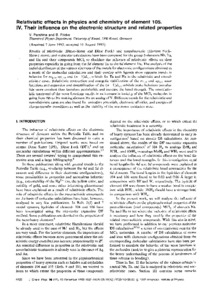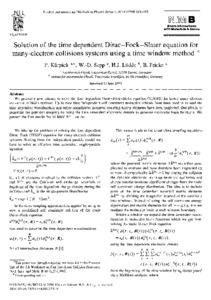Suche
Anzeige der Dokumente 1-10 von 37
Aufsatz
 Spin-polarized Hartree-Fock-Slater calculations in atoms and diatomic molecules with the finite element method
Spin-polarized Hartree-Fock-Slater calculations in atoms and diatomic molecules with the finite element method
(1990)
We present spin-polarized Hartree-Fock-Slater calculations performed with the highly accurate numerical finite element method for the atoms N and 0 and the diatomic radical OH as examples.
Aufsatz
 A clear atomic example for the surface sensitivity of penning ionization
A clear atomic example for the surface sensitivity of penning ionization
(1990)
Using a crossed-beam apparatus with a double hemispherical electron spectrometer,
we have studied the spectrum of electrons released in thermal energy ionizing collisions of metastable
He^*(2^3S) atoms with ground state Yb(4f^14 6s^2 ^1S_0) atoms, thereby providing the first Penning electron spectrum of an atomic target with-4f-electrons. In contrast to the HeI (58.4nm) and NeI (73.6/74.4nm)
photoelectron spectra of Yb, which show mainly 4f- and 6s-electron emission in about a 5:1 ratio, the He^*(2^3S) Penning ...
Aufsatz
 Relativistic effects in physics and chemistry of element 105. [Part] IV.
Relativistic effects in physics and chemistry of element 105. [Part] IV.
(1993)
Results of relativistic (Dirac-Slater and Dirac-Fock) and nonrelativistic (Hartree-Fock-Slater) atomic and molecular calculations have been compared for the group 5 elements Nb, Ta, and Ha and their compounds MCl_5, to elucidate the influence of relativistic effects on their
properties especially in going from the 5d element Ta to the 6d element Ha. The analysis of the radial distribution of the valence electrons of the metals for electronic configurations obtained as a result of the molecular calculations and their ...
Aufsatz
 Inclusive probabilities for the scattering system 16 MeV-S{^16+} on Ar
Inclusive probabilities for the scattering system 16 MeV-S{^16+} on Ar
(1991)
We performed ab initio calculations of many particle inclusive probabilities for the scattering system 16 MeV-S{^16+} on Ar. The solution of the time-dependent DIRAC-FOCK-SLATER-equation is achieved via a set of coupled-channel equations with energy eigenvalues and matrix elements which are given by static SCF molecular many
electron calculations.
Aufsatz
 Solution of the time dependent Dirac-Fock-Slater equation for many-electron collisions systems using a time window method
Solution of the time dependent Dirac-Fock-Slater equation for many-electron collisions systems using a time window method
(1994)
We present a new scheme to solve the time dependent Dirac-Fock-Slater equation (TDDFS) for heavy many electron ion-atom collision systems. Up to now time independent self consistent molecular orbitals have been used to expand the time dependent wavefunction and rather complicated potential coupling matrix elements have been neglected. Our idea is to
minimize the potential coupling by using the time dependent electronic density to generate molecular basis functions. We present the first results for 16 MeV S{^16+} on Ar.
Aufsatz
 Precision laser spectroscopy of the ground state hyperfine splitting of hydrogenlike ^209 Bi^82+
Precision laser spectroscopy of the ground state hyperfine splitting of hydrogenlike ^209 Bi^82+
(1994)
The first direct observation of a hyperfine splitting in the optical regime is reported. The wavelength of the M1 transition between the F = 4 and F = 5 hyperfine levels of the ground state of hydrogenlike ^209 Bi^82+ was measured to be \lamda_0 = 243.87(4) nm by detection of laser induced fluorescence at the heavy-ion storage ring ESR at GSI. In addition, the lifetime of the laser excited F = 5 sublevel was determined to be \tau_0 = 0.351(16) ms. The method can be applied to a number of other nuclei and should allow ...
Aufsatz
 First results of experimental and theoretical investigations on sextet states of doubly-excited five-electron ions
First results of experimental and theoretical investigations on sextet states of doubly-excited five-electron ions
(1992)
In continuation of our previous work on doubly-excited ions with three and four electrons we present the first results on optical transitions in the term system of doubly-excited ions with five electrons. Transitions between such sextet states were identified in beam-foil spectra of the ions nitrogen, oxygen and fluorine. Assignments were first established by comparison with Multi-Configuration Dirac-Fock calculations. Later assignments were aided by Multi-Configuration Hartree-Fock calculations (see the contribution ...
Aufsatz
 Further investigations on doubly excited four-electron ions: beam-foil experiment and MCDF theory
Further investigations on doubly excited four-electron ions: beam-foil experiment and MCDF theory
(1991)
In continuation of our previous work on the quintet transitions 1s2s2p^2 ^5 P-1s2s2p3d ^5 P^0, ^5 D^0, results on other n = 2 - n' = 3 quintet transitions for elements N, 0 and F are presented. Assignments have been established by comparison with Multi-Configuration Dirac-Fock calculations. High spectral resolution on beam-foil spectroscopy was essential for the identification of most of the lines. For some of the quintet lines decay curves were measured, and the lifetimes extracted were found to be in reasonable ...










